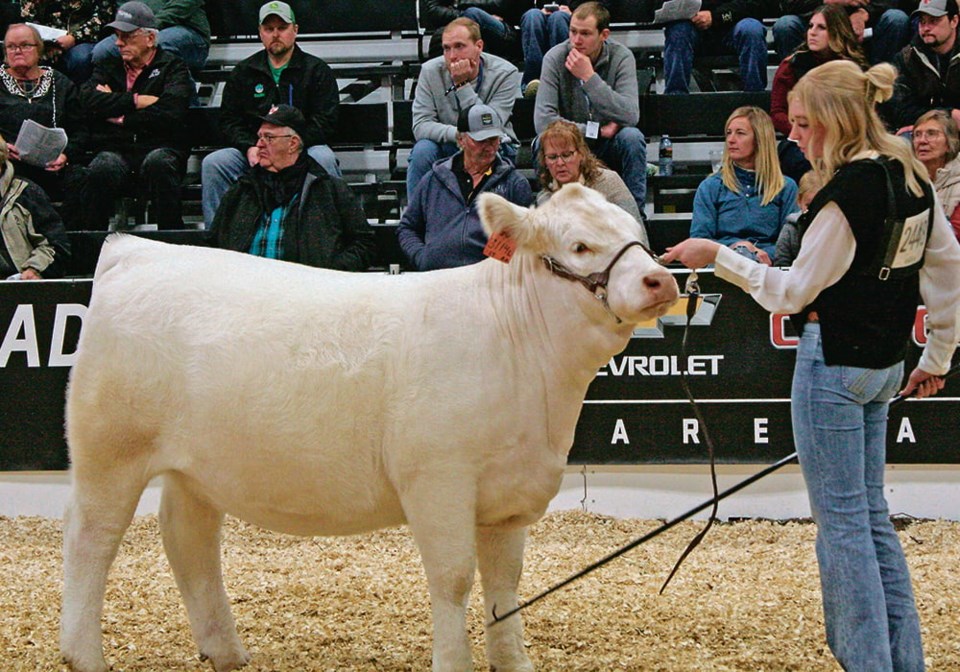REGINA — Two Swedish visitors to Canadian Western Agribition spent a lot of time looking at legs.
Charolais legs, to be exact.
Patrik Gustafsson and Emil Martensson agreed they didn’t really like the legs on the North American cattle because they wouldn’t serve their animals well.
“Legs is a big thing in Sweden. I think we both feel like the legs here are kind of bad, actually,” said Gustafsson.
“They are really straight. We want ours a little bit angled and not so big,” added Martensson. “They are walking really bad, we think, and it’s really important on the back legs.”
The issue is the Swedish terrain. It’s hillier and breeders rely more on natural reproduction; the animals need to be strong on pasture.
“We don’t use a lot of semen like you do here because we can’t draw the bull at home,” Gustafsson said. “We want to have two or three bulls that actually we can use in AI in Sweden, so then the bull needs to cover the cows at home.”
He said it’s normal in Sweden to see cows that are 10 or 15 years old and good legs are critical to that longevity.
The two young men from the southern part of Sweden said they are also looking at growth performance in North American animals. They both were in Canada at the Charolais youth conference in 2018 so they knew what to expect on their trip to Agribition and on farms they visited ahead of the show.
Swedish Charolais breeders have both French and Canadian genetics, with some more heavily weighted to one than the other, they said.
“I’m taking a lot of pictures of their animals and their pedigrees,” said Gustafsson, as they consider what genetics they might want to import in future.
They don’t want cows that are too small, they said.
The two farm about an hour away from each other and were raised on Charolais farms of about 50 head for Gustafsson and 100 for Martensson. Charolais is the dominant breed in Sweden.
Martensson is working on the country’s largest Angus farm of about 200 head and expects to return to his family farm in about 10 years. He said he doesn’t feel like he must raise Charolais but they suit his family’s land.
Farmers are required to have buildings for their cattle because of rain and mud.
Winter temperatures are about -5 C from the end of December into early February. The rest of the time it is grey, raining and muddy, they said, and they keep the cattle off the land to preserve it.
“In the north part, they just think it’s too cold for the cows to go outside,” Martensson said of building requirements.
Cattle that are allowed outside must have access to a shelter with three walls and a roof.
They said farmers are used to the strict animal welfare rules.
Another difference between the two countries is the prevalence of on-farm bull sales in Canada. There are none in Sweden, Gustafsson said.
“Being at Agribition is a so fun trip because we have only one show every second year in Sweden, so 小蓝视频 at this big show and see the cattle and see the fitting and the atmosphere is so fun,” Gustafsson said. “We don’t do that much fitting at all in Sweden, especially because we only have that one show every second year. To get that knowledge you have here, it takes a lot more time.”
The top seller at the Agribition Charolais sale was a heifer calf. KAYR Laine 366L from Kay-R Land and Cattle at Waskatenau, Alta. sold for $20,5000 to Rancho La Providencia in Jalisco, Mexico.
In the show ring, Serhienko Cattle Co. from Maymont, Sask., showed the grand champion female, SVY Covergirl 232K, and the reserve champion bull, SVY Trademark 341L.
Kay-R showed the reserve female, Covergirl 265K, while the grand champion bull, SOS Kickstart PLD 825K, came from Steppler Farms in Miami, Man., Springside Cattle Corp. and Peter Peters.





Bookmark SASKTODAY.ca, Saskatchewan's home page, at this link.